 When we started researching the type of fencing needed for our Nigerian Dwarf and Miniature Silky Fainting Goats, we were CONFUSED!
When we started researching the type of fencing needed for our Nigerian Dwarf and Miniature Silky Fainting Goats, we were CONFUSED!
Much of the advice we found was intended for livestock fencing, or at best, for larger breed goats. Although a lot of the information was useful, we found it just wouldn’t work for containing our LITTLE goats, and keeping them safe from predators.
So, because of this, we wanted to help others in the same position that we were. Hopefully you’ll find the following tips useful when planning and building your own goat fencing for miniature breed goats.
5 TIPS for Goat Fencing for Your Miniature Goats
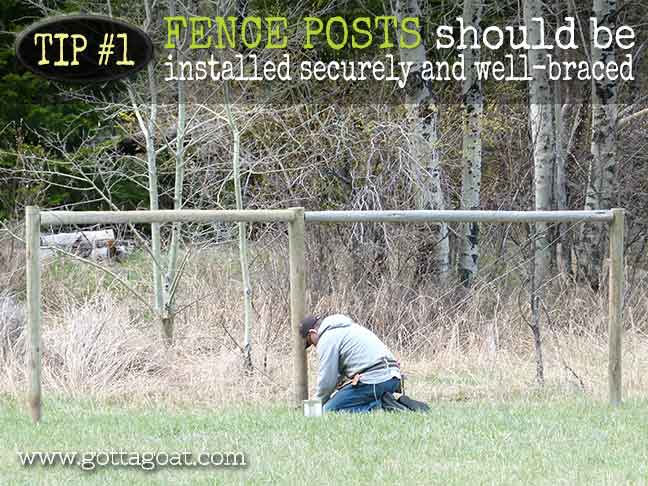
TIP #1: FENCE POSTS – Your post selection and installation is a very important part of your fence. You need to make sure each post is secure, and the corner and gate posts are well-braced. Even though your miniature goats are small, they are stronger than they look, so don’t be tempted to take shortcuts when building your fence. You should still follow most standard livestock fencing guidelines for installing your fence posts.
- For our posts we chose 7 – 8 foot pressure treated posts (4 – 5″ in diameter, with larger ones for the gates and corners), which were pounded into the ground 2 – 2.5 feet. The standard rule-of-thumb here is that 1/3 of the height of the post should be in the ground.
- For a wire height of 5 feet, you’ll want to make sure you have at least a couple inches higher than 5 feet of post sticking out of the ground (so mark your posts before pounding them in, to make sure you don’t set them too deep). This should give you enough room on the posts to make sure the top wire can be attached securely.
- H-braces should be installed at each of the corners, and next to any gate openings, as these are the areas where the most tension on your fence will be. We set our bracing just below 5 feet, which allowed us to staple the top of the fence wire along the brace. Diagonal wire bracing should also be installed at these points. This wire should be installed to put opposite tension on the fence run – so the wire should be attached at the BOTTOM of the corner post, and run to the TOP of where the H-brace is attached to the next fence post.
- Posts should be no more than 10 feet apart for the main fence runs, and for extra support, they should be installed 8 feet apart where your H-bracing will be located. You will find a lot of good information regarding the “physics” of the actual force that is exerted on the corner posts, and the optimal distance for the brace posts (much of which is based on the length of your fence runs and height of your fence). However, what we found was that much of this is based on barbed wire, or high tensile wire installations, or is calculated with the wire was installed on the outside of the posts. Based on the relatively short runs for our pasture, we found that the 8 foot H-brace distance worked best, and the 10 foot post spacing was a distance that works well for the type of wire we were using.
- ADDITIONAL TIP: Using concrete to secure your posts is usually recommended for posts supporting heavy gates, but for the remaining posts it can be very expensive, especially for a large area. Digging post holes and backfilling may work in your area, but we have very sandy soil, and any posts we’ve installed in this manner are just not secure enough (they start to “wiggle” and lean after a while, no matter how hard we pack in the back fill around the posts). Post-pounding has proven to be the most secure (and cost effective) solution for our fence posts, even those supporting our gates.
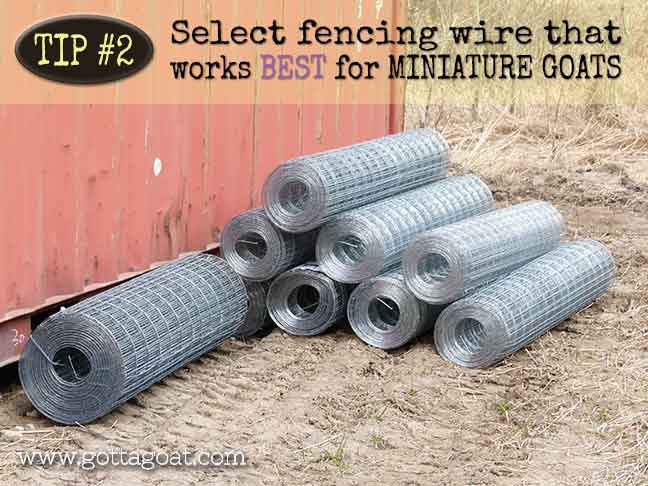
TIP #2: WIRE SELECTION – Your miniature goats can squeeze through VERY small openings, especially when they are young, so choose your fencing wire with this in mind.
- The 4″x4″ fence wire sold as “goat fence” by your agriculture or hardware store probably won’t work for your younger miniature goats. If you are planning on breeding your mini’s, those kids will be VERY tiny, so again, this wire will not work (even if it does manage to contain your larger goats). It is probably best to avoid it if possible.
- Graduated “field fence”, although one of the cheapest solutions for lengthy pasture applications, will typically have openings that are too large for miniature goats.
- The best solution we found was 2″x4″ wire fencing, often sold as “no-climb horse fence”. There are two types of this fencing wire sold: welded wire (less expensive, and may not last as long, but not a bad choice), and woven wire (more expensive, but the best choice, as it will last longer). Although this fencing may cost a bit more initially, it is definitely worth the investment. By installing a five-foot high fence of this type, you can also eliminate the need to add additional electric fencing wire (which you may have to with some of the other options). It is also much safer for your little ones, as they cannot get their heads through these small openings, preventing them from getting stuck!
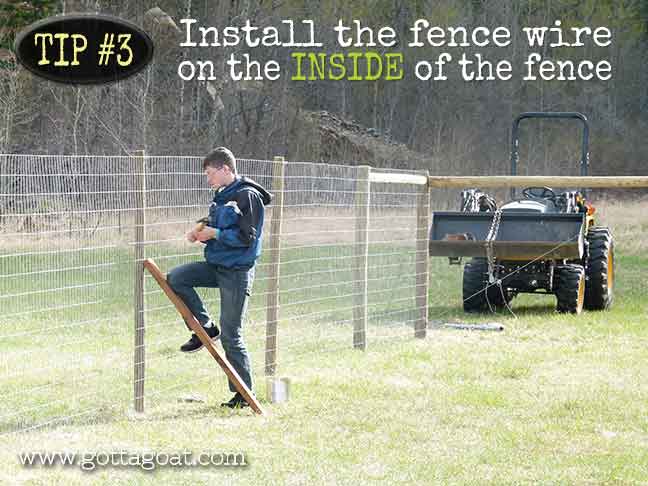
TIP #3: WIRE INSTALLATION – The most important thing to remember is to install the wire on the INSIDE of the fence. This was where it got a bit confusing for us at first, as almost all the pictures and instructions we found showed the wire installed on the outside of the fence. However, once we got started building the fence, it began to make sense.
- Let me start with the installation recommendations:
- The wire should be installed on the INSIDE of the pasture, since the goats leaning and rubbing against the fence (and they will do this A LOT) will put significant pressure on your wire, and even push out the staples if it’s installed on the outside of the posts.
- You will also want to have your diagonal wire bracing (used on the corners and gate posts) OUTSIDE of the fencing wire, to prevent your goats from using it as a ramp to climb up and out of their pasture.
- To actually do the inside installation took some thought.
- The first run of wire is pretty straight forward. It is attached to one end post by wrapping each of the horizontal wires around the post (removing enough of the vertical wires to give you sufficient length to twist the horizontal wires back onto themselves). It then gets stapled on, down the post.
- The wire is then stretched along the length of the run. We used a come-along, chained to the bucket of our tractor, and a metal fence stretcher rod that has several hooks for attaching the wire, to help with this process. So, depending on where the top of the fence is in relation to your H-brace, you will probably need to cut some of the vertical wires at the top of the fence before you stretch it, which will allow you to pull the fence straight.
- Once you have the fence pulled tight, each of the horizontal wires at the end of the run will be wrapped around the post and twisted back onto themselves (again, cutting the vertical wires as needed). We first stapled the wire onto the post, and then wrapped around the top horizontal wires. We also stapled the wire to the line posts (along the fence run) while it was still nice and tight. We then loosened the come-along, and worked our way down the end post, wrapping around each of the horizontal wires.
- The second run of wire is a bit trickier. It also needs to have the horizontal wires wrapped around the end post, but in order to do this on a post that already has wire installed on the inside, you will need to cut away a lot more of the vertical wires to give yourself longer lengths of horizontal wires. These wires are then woven through the existing fence and twisted onto themselves. This is a fairly time consuming process (and hard on the hands, having to cut through a substantial number of vertical wires). Make sure to get yourself a GOOD pair of wire cutters for this job!
- The wire for this run (and the next runs) of fence will be stretched as before, stapling it onto each post and wrapping the horizontal wires around the end posts.
- Before you’re finished, make sure to trim the ends off all the cut wire you’ve twisted together. You want to prevent anyone from hurting themselves on those sharp pieces poking out!
- ALTERNATIVELY: When you have longer runs of wire, some of your rolls will need to be spliced together. So instead of splicing it together first and then pulling your fencing wire from the end of your run, you may want to try tying off a roll of wire to each of the end posts and stretching both rolls toward the middle of the fence run. I had found some interesting information on this type of wire installation, and it sounded like it might be an effective solution for longer fence runs. Have a look at this website for information on their technique: Installing the Fence Wire.
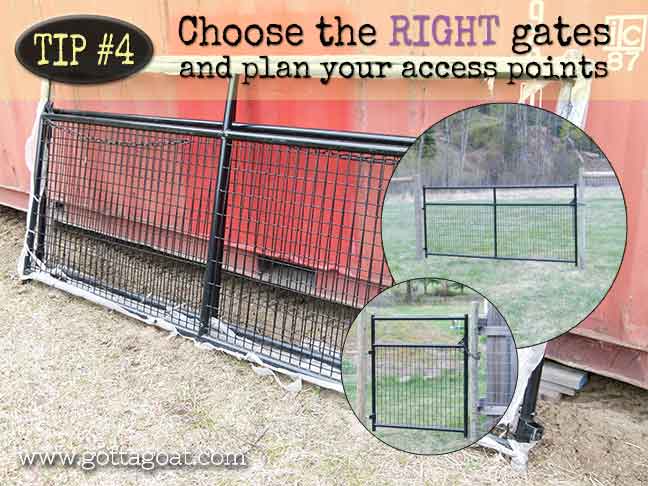
TIP #4: GATES – Plan your access points carefully, so that both you and your equipment can easily enter and exit your new goat pasture. And make sure the gates you choose can stand up to your goats jumping on them – frequently!
- Choose the strongest gates you can afford. Remember, these will be where your goats come to greet you, and they will want to jump on them, rub against them, and poke their noses through them to see what treats you may have brought.
- Metal/steel gates are a great choice, as they are very durable, come in a variety of sizes, and typically include all the necessary installation hardware. We chose powder-coated steel tube gates with welded 2″x4″ mesh, in 10 foot widths (for our tractor access points), and 4 foot widths, for “people access”.
- These gates are hung with bolts installed through the fence posts, and include a chain closure. Although our goats haven’t tried to “open” these, we do use a carabiner locked on each chain for added security.
- No matter how well your gates fit into the openings, your goats may still find a way to squeeze through – so be prepared! We installed our gates a few inches off the ground to allow for clearance when we have snow. However, there was just enough room between the post, the gate, and the ground for our little ones to squeeze out (and of course this happened the first day we brought them home!). So, we have had to install a few temporary boards around the gate openings, to prevent further escapes (at least until our little ones are not so little).
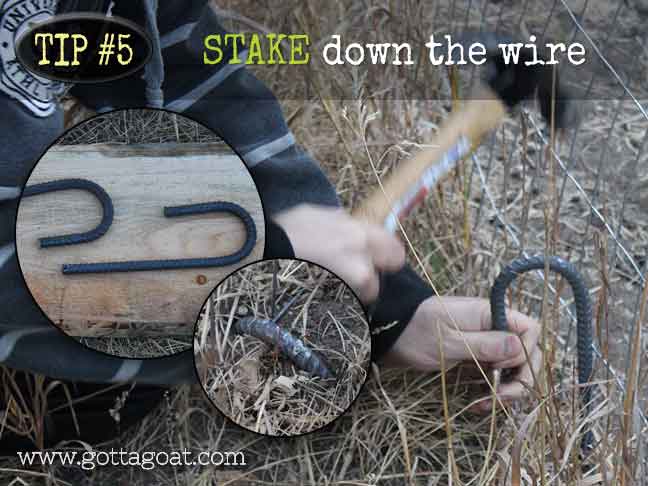
TIP #5: FOR EVEN GREATER SECURITY… As I mentioned earlier, your goats will rub back and forth along the fence wire every chance they get (which is part of the reason for installing the wire on the inside of the fence). This really loosens the wire over time, so as an additional measure, you can stake down the wire along your fence. This extra precaution can help A LOT in preventing your goats from pushing their way under the fence, and, at the same time, can help to protect your goats from predators getting underneath a loose wire fence.
- For the fencing stakes, you will probably have to get a bit creative, as ready-made stakes designed for this purpose might be hard to find. Over the years, we’ve used a number of different “homemade” solutions for staking things to the ground. For example, we’ve used stakes to help hold small buildings in place in extremely windy locations, to hold down wire fencing to prevent our dogs from digging and pushing their way underneath, and to help anchor the wire at the base of our chicken run. In each case, we’ve used everything from tent spikes, to L-shaped lengths of “forged sugar beet chain” which Jeff’s dad gave us from his farm a number of years ago. Essentially, any rugged metal with some form of hooked end should work quite well. Just make sure it is heavy enough to be hammered into the ground without buckling, and long enough so that it won’t pull out easily.
- For our current goat fencing, we no longer had Jeff’s parent’s farm close by, so we went to a metal salvage company, who fabricated rebar into 10″ lengths, and bent the tops over into a “candy cane” shape. These make-shift fence stakes were pounded into the ground to hold the bottom of the fence wire in place between the posts. The rebar itself was relatively inexpensive, but we had to pay extra for the labour to bend the stakes into shape. So far, this seems to be working well to keep the wire in place.
So, there you have it. For those of you who are just getting set up for miniature goats, we hope you find this information helpful. And for those who already have miniature goats, we’d love to hear your own tips for keeping your goats secure!

We are getting two Nigerian dwarf goats once they’re weaned in May. We’ve been raising chickens and turkeys for about six years and have had ducks in the past, but this is our first time for goats and I’m feeling a bit nervous. I’m very grateful that you’ve taken the time to supply this information. We will definitely keep referring back to it as we get things set up for our little ones.
I’m so glad you’re finding this helpful! Sorry for the late reply, but we’ve been busy with our new chicks, and building a new coop for all of them. Always seems to be something taking up our spare time 🙂
Good luck with your new Nigerian Dwarf goats – I’m sure you will just love them. I know we have just fallen in love with ours. They are so very sweet, and tons of fun!
Hiya, love your smart website, Ironically I got to this page via ideas for my new Chicken coop I’m about to erect. However, last year I gained my first goats, 2 pygmy wethers and 2 mixed dairy ladies, likewise, I just love them! Wandered if you had made a small amount of money from the goats at all e.g. via their coat or milk products?
Thanks, love
Daisy (all the way from the UK)
Thanks for visiting! We’ll be breeding our goats this fall, so we’ll have some amazing kids for sale in the spring. Not sure if we’ll be offering any dairy products for sale, but who knows? However, we have been adding to our chicken flock over the past few months so we will have a lot of eggs for sale by August, once they all start laying. Lots of fun, and we just love having the goats and chickens here.
For my Nigerians I used pallets for fencing. The spacing between boards was too great for when my first goat popped out two surprise babies, so when we moved we screwed boards along the bottom to keep babies in (as well as our ducks when they were babies). And with the pallets that are available in my area, I had to screw a half pallet to the top to keep my jumper in. But we only use it as a pen for night time. On sunny days they get tied in a location where I can keep an eye on them with my GSD (a good breed for herding a guarding livestock). And while I’m sure t posts would work better, all that’s holding our pen together is good ole orange jute and some 2x4s cut into foot long sections and pounded into place to lock the pallets together.
While this works, I still dream of the day when their entire pasture is fenced securely enough to let them have free range.
Do you have a picture of how you have done the corners when you have the fence inside the posts? Also, where the heck did you get those awesome looking stakes? None of my local livestock/feed stores have then, nor does Home Depot. They have wimpy stakes that are more for bunnies or small dogs.
I just read how you made the stakes.
Glad you found that info! They have really worked great for us.
Would be interested to know how you “pounded down” large wooden fence posts. My understanding is that there is a hydraulic machine that commercial fence installers use that costs zillions of dollars. Also, I’m doubtful that this method works in rockier soils, in any case. I dig post holes with a tractor-mounted augur and then pack posts in with a mixture of about 1/4 concrete mix, 1/3 dry clay, and the rest gravel, tamping as I go (a stick will work where the tamping iron won’t fit). This mix holds the post as securely as concrete, is much cheaper, attracts less water than concrete, and drains better. Pure concrete accelerates rot because a pocket forms in the ground around the post and the water just sits there against the post forever.
Hi – we use a hydraulic post pounder. It connects to the 3 point hitch of our tractor. We bought it used, so it is a little temperamental, but does the job! It was under $1000, so definitely not as much as the bigger units. Thanks for your input on the surrounding mix around posts – that is good to know!
Hi, I’m building a fence for our Nubian goats this spring I’m gonna go with chain linked fence, its a bit more expensive but worth it for the long run. I was wondering did you put your coner post on the inside of the fence or on the outside juste like the rest of the fence. If you put it on the outside how did you attach your fence on it? Because if you put it on the outside of the fence the force would try to pull out the staples at the corner post.
Hi Fred – We did not run the wire around the corners, because, as you noted, the force would push on the posts. What we did at each corner was pull the wire past the corner post (on the inside), staple down the length of the post, and then cut the wire and wrap each strand around the post and tie back onto itself. It is a lot of extra work, but will make the fence much stronger! It is hard to describe this in words, so I hope this makes sense.
I am just getting started in the pygmy goat business and trouble started about the 4th week. I first acquire a mama (about 2 years old) with a buckling (about 4 weeks old). About the 4th week, mama was found dead (cannot figure out why…spider, bloat, snake, who knows). So I promptly went to another local pygmy farmer and acquire two does. Cute, cunning rascals!! I put them in my corral (originally built for horses) to find they could walk right through the fence. So, I lined the inside with “goat and sheep” fence and the next morning they were gone!!! How did they get out? No holes, no gaps! Ah, I found them rascals could jump and climb over!! All that to say: This has been the best (the BEST) article to date on corralling these cunning little rascals. So, back to the drawing board. I now want portable fence panels to move them around my property. I didn’t go into this for pet goats, they are to work on my underbrush and get paid in lots and lots of food!!!
So sorry to hear about your mama goat. Hope the others are all doing well! And yes, they are sneaky – our larger goats (usually) don’t get out anymore, but we’ve had a couple of the kids squeeze through the sides of the gate, and now we have one very smart buck who knows how to open his gate (we have started putting a carabiner on the latch to keep him from escaping)! Glad you liked our post, and thanks for your comment.
Have just acquired enough land to raise some chickens and maybe a goat or two. Your post about fencing in the goats is very informative . It will help us greatly in planning their pen. Thank you
Thank you!
Remember to get at least two compatible goats (does with does or wethers/ wethers with wethers) to keep each other company! They are herd animals and would be lonely by themselves 🙂
Definitely!
Thanks for the tip that 2″ x 4″ wire fencing is optimal for in preventing animals from jumping over it. My husband has been convincing me for us to start taking care of goats as livestock so it’s only natural to start looking in to good farm fencing options. I think wire fencing would also be a good choice since it won’t block ventilation much.
Do you have pictures of your fence?
Y’all have the most practical fence information I’ve seen.
I’m so sorry for the late reply! I’m glad you like our site. We have a lot more photos on our Facebook page (https://www.facebook.com/GottaGoat/), and we have expanded our fencing quite a bit since I had originally created this post. You can also message us directly through Facebook, if there was something specific you wanted to see, and we can send photos to you!
Great info! Thank you! Wondering where you got the gates that you use. Also, we are looking for information on making the pens inside our pole shed. It’s already concreted, so we’re looking for what we can do to secure their pens and also construct the most uniform, safe, and secure pens.
Thanks! The farm store we purchased our gates from is no longer in business, but you should be able to find them at just about any farm or agricultural supply store, or fencing suppliers will also carry them. If your barn floor is already concrete, I would think you’d have to build your pen/stall walls in a similar way to how you would frame walls for a basement (if you are planning on using lumber for the framing). Otherwise, I believe there are a lot of pre-fab barn/stall products that you could look into.
For those thinking about raising these beautiful animals, please reference several message boards and sites before you even start preparing your land for a fence. I went with the standard, highly recommended 4ft woven-wire sheep/goat fencing from Red Brand. Although the quality of the material is great, even the small Nigerian dwarf goats can easily escape over the 4ft. fence. One of my girls, not quite a year old, can easily clear a 5 foot fence with very little of a running head start. These goats are so incredibly nimble and physically amazing creatures.
New and prospective ND goat owners, please opt for a 6 foot fence if you don’t want them escaping. You can have every possible food, water, minerals, soda, treats and toys and they will often STILL try and escape. My main troublemaker is very attached to people, so she will do whatever it takes to visit with someone she hears or sees near our property. Once she gets out, the others follow as they think she will get something they don’t. It’s quite funny but also frustrating and time consuming to have to constantly reinforce and heighten a 4 ft fence. Just get 6ft from the beginning, even welded wire if cost is a problem! Though the welded wire will break down faster, it may be cheaper to replace as needed than constantly having to fix escape areas on the 4ft woven wire. You’ve been warned, lol.
We bought a beautiful baby doe to become a companion to our young horse who has separation anxiety. We have 5″ plus fencing and she sails over it like it is nothing. She likes him, but she likes humans and dogs better. We love her, but she is a rascal. We even found her in the rafters of our garage recently. She uses the dog door. The horse fences all are topped with hotwire. So what? None of it stops her coming to the house. I think if we get another goat we will just have two goats coming in the dog door. Goats 100, humans 0.
I wish I would have found this article just 2 days ago. I am now taking the fencing down & doing it your way. Extra work but after reading your set up I would rather do it correctly the first time. No regrets! Thank you so much!
Awww, glad we could help (even if a little late)!